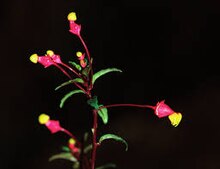Burmeistera is a genus of flowering plants in the bellflower family, Campanulaceae. There are around 130 species distributed in Central and South America.[1][2] This genus represents a rapid evolutionary radiation with species having diverged within only the last 2.6 million years.[3][4]
| Burmeistera | |
|---|---|

| |
| Burmeistera minutiflora | |
| Scientific classification | |
| Kingdom: | Plantae |
| Clade: | Tracheophytes |
| Clade: | Angiosperms |
| Clade: | Eudicots |
| Clade: | Asterids |
| Order: | Asterales |
| Family: | Campanulaceae |
| Subfamily: | Lobelioideae |
| Genus: | Burmeistera H.Karst. & Triana |
| Species | |
|
Many, see text | |
These are herbs, shrubs, or lianas. Most have either green or yellow flowers with purple markings and inflated fruit pods.[5]
The flowers of these plants are pollinated by bats, except for Burmeistera rubrosepala, which is pollinated by hummingbirds. Bats such as Anoura geoffroyi and Anoura caudifer visit the flowers for the nectar.[1]
Species include:
- Burmeistera anderssonii
- Burmeistera asplundii
- Burmeistera auriculata[5]
- Burmeistera brachyandra
- Burmeistera crispiloba
- Burmeistera cuyujensis
- Burmeistera cyclostigma
- Burmeistera cylindrocarpa
- Burmeistera domingensis
- Burmeistera formosa
- Burmeistera holm-nielsenii
- Burmeistera huacamayensis
- Burmeistera ignimontis
- Burmeistera loejtnantii
- Burmeistera microphylla
- Burmeistera oblongifolia
- Burmeistera oyacachensis
- Burmeistera parviflora
- Burmeistera racemiflora
- Burmeistera refracta
- Burmeistera resupinata
- Burmeistera rubrosepala
- Burmeistera sodiroana
- Burmeistera tenuiflora
- Burmeistera truncata
References
editWikimedia Commons has media related to Burmeistera.
- ^ a b Muchhala, N., & Potts, M. D. (2007). Character displacement among bat-pollinated flowers of the genus Burmeistera: analysis of mechanism, process and pattern. Proceedings of the Royal Society of London B: Biological Sciences, 274(1626), 2731-2737.
- ^ Mashburn, Brock (2019-05-28). "A Taxonomic Revision of the Genus Burmeistera (Campanulaceae) in Ecuador". Theses.
- ^ Lagomarsino, Laura P.; Forrestel, Elisabeth J.; Muchhala, Nathan; Davis, Charles C. (2017). "Repeated evolution of vertebrate pollination syndromes in a recently diverged Andean plant clade". Evolution. 71 (8): 1970–1985. doi:10.1111/evo.13297. ISSN 1558-5646. PMID 28640437.
- ^ Lagomarsino, Laura P.; Condamine, Fabien L.; Antonelli, Alexandre; Mulch, Andreas; Davis, Charles C. (2016). "The abiotic and biotic drivers of rapid diversification in Andean bellflowers (Campanulaceae)". New Phytologist. 210 (4): 1430–1442. doi:10.1111/nph.13920. ISSN 1469-8137. PMC 4950005. PMID 26990796.
- ^ a b Muchhala, N., & Lammers, T. G. (2005). A new species of Burmeistera (Campanulaceae: Lobelioideae) from Ecuador. Archived 2006-09-05 at the Wayback Machine Novon, 15, 176-179.